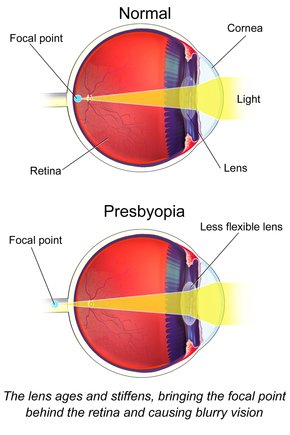Presbyopia
| Presbyopia | |
|---|---|
| Other names | The aging eye condition |
| Frequency | 25% currently;[3] all eventually affected[1] |
Presbyopia is physiological insufficiency of accommodation associated with the aging of the
Presbyopia is a typical part of the aging process.
Presbyopia can be corrected using
People over 40 are at risk for developing presbyopia and all people become affected to some degree.[1] Around 25% of people (1.8 billion globally) are currently affected.[3]
Signs and symptoms
The first symptoms most people notice are difficulty reading fine print, particularly in low light conditions,
Presbyopia, like other focal imperfections, becomes less noticeable in bright sunlight when the pupil becomes smaller.[8] As with any lens, increasing the focal ratio of the lens increases depth of field by reducing the level of blur of out-of-focus objects (compare the effect of aperture on depth of field in photography).
The onset of presbyopia varies among those with certain professions and those with
Interaction with myopia
People with low
A surgical technique offered is to create a "reading eye" and a "distance vision eye", a technique commonly used in contact lens practice, known as
Mechanism

The cause of presbyopia is lens hardening by decreasing levels of α-crystallin, a process which may be sped up by higher temperatures.[11] It results in a near point greater than 25 cm[12] (or equivalently, less than 4 diopters).
In optics, the closest point at which an object can be brought into focus by the eye is called the eye's near point. A standard near point distance of 25 cm is typically assumed in the design of optical instruments, and in characterizing optical devices such as magnifying glasses.[citation needed]
There is some confusion over how the focusing mechanism of the eye works.[
The ability to focus on near objects declines throughout life, from an
Diagnosis
A basic eye exam, which includes a refraction assessment and an eye health exam, is used to diagnose presbyopia.
Treatment
In the visual system, images captured by the eye are translated into electric signals that are transmitted to the brain where they are interpreted. As such, in order to overcome presbyopia, two main components of the visual system can be addressed: image capturing by the optical system of the eye and image processing in the brain.
Image capturing in the eye
Solutions for presbyopia have advanced significantly in recent years due to widened availability of optometry care and over-the-counter vision correction options.
Corrective lenses
Surgery
Refractive surgery has been done to create multifocal corneas.[16] PresbyLASIK, a type of multifocal corneal ablation LASIK procedure may be used to correct presbyopia. Results are, however, more variable and some people have a decrease in visual acuity.[17] Concerns with refractive surgeries for presbyopia include people's eyes changing with time.[16] Other side effects of multifocal corneal ablation include postoperative glare, halos, ghost images, and monocular diplopia.[18]
Image processing in the brain
A number of studies have claimed improvements in near visual acuity by the use of training protocols based on perceptual learning and requiring the detection of briefly presented low-contrast Gabor stimuli; study participants with presbyopia were enabled to read smaller font sizes and to increase their reading speed.[19][20][21][22]
Eye drops
Pilocarpine, eye drops that constrict the pupil, has been approved by the FDA for presbyopia.[23][24] Research on other drugs is in progress.[25] Eye drops intended to restore lens elasticity are also being investigated.[26]
Etymology
The term is from
History
The condition was mentioned as early as the writings of Aristotle in the 4th century BC.[29] Glass lenses first came into use for the problem in the late 13th century.[29]
See also
- Vuity
References
- ^ a b c d e f g h i j "Facts About Presbyopia". NEI. October 2010. Archived from the original on 4 October 2016. Retrieved 11 September 2016.
- ^ S2CID 205049139.
- ^ PMID 29753495.
- ^ ISBN 978-81-312-1132-8.
- ^ "5 Facts About Age-Related Farsightedness You Probably Didn't Know". www.webmd.com. Retrieved 2 February 2022.
- ^ "Age-related Long Sight". patient.info. Retrieved 2 February 2022.
- ^ "PresbyLASIK - EyeWiki". eyewiki.aao.org. Retrieved 27 August 2020.
- Marquette, MI: Eye Associates of Marquette. 2008. Archived from the originalon 2 December 2008. Retrieved 31 October 2010.
- from the original on 7 October 2011.
- PMID 22692711. Archived from the original on 19 April 2013. Retrieved 19 April 2013.)
{{cite journal}}: CS1 maint: unfit URL (link - S2CID 26015190.
- ISBN 978-1-305-53720-0.
- ISBN 978-0070246652.
- ^ Robert P. Rutstein, Kent M. Daum, Anomalies of Binocular Vision: Diagnosis & Management, Mosby, 1998.
- PMID 16597675.
- ^ S2CID 4474834.
- S2CID 35434343.
- OCLC 853286620.
- PMID 25431233.
- PMID 22363834.
- PMID 24269381.
- S2CID 20260936.
- ISSN 0362-4331. Retrieved 15 December 2021.
- ^ "Vuity". drugs.com. Retrieved 9 February 2022.
- S2CID 139101960.
- PMID 33514891.
- ^ "Presbyopia". Dictionary.reference.com. Archived from the original on 12 April 2013. Retrieved 19 April 2013.
- ^ "Presbyopia". Etymonline.com. Archived from the original on 18 August 2017. Retrieved 4 May 2017.
- ^ ISBN 9780262731294. Archivedfrom the original on 8 September 2017.
External links
- "Presbyopia" at MedLinePlus Medical Encyclopedia
